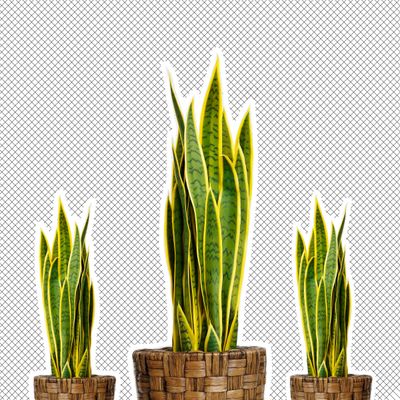
Welcome to Bad at Plants, a new column in which plant expert Maryah Greene, of Greene Piece consulting, answers your questions about plants, so that we might all become at least slightly better at keeping them alive.
“A new little leaf guy started to grow from my snake plant, and I was afraid he didn’t have enough room where he was, so I tried putting him in his own pot. But that was, like, months ago, and he is not growing anymore. I guess if he was DEAD I would be able to tell? But he was growing so fast, and now he’s stopped?”
Okay, so two things might have happened here:
Possibility A: If the cutting was initially growing when placed in a new pot of soil, and has suddenly stopped growing, it is possible that the plant is exhibiting some symptoms of dormancy. During this period, growth and development come to a temporary stop due to a multitude of factors. One of the most common is a change in environmental conditions.
Possibility B: The other reason it may have stopped growing above the soil is that it’s simply stretching out its roots underneath the soil. Just because you don’t see any action taking place above the soil, it doesn’t mean that growth isn’t occurring underneath. Sometimes my plants show extreme amounts of growth and out of nowhere, they take a break. Trust that there is still life under the soil, even if the eye can’t see it.
I think it’s likely Possibility B.
Taking a step back: There are different ways to propagate the plant depending on the type of plant. In the case of a snake plant, what I recommend is to start it off in some water for a bit. Because snake plants are in the cacti family, they’re used to holding a lot of moisture, which is why they don’t need to be watered as often. It sounds like what you did was to cut the plant and put it in a new pot with fresh soil, which can totally be done, but I recommend starting in water first just so you can get the roots going and you can see that you’ve actually propagated successfully, in the sense that roots are growing in the water.
You can use a cup of water, a jar, or something that allows the plant to sit in water without touching the bottom, so there’s enough room for the roots to grow. The whole thing doesn’t need to be submerged in water. Then, you want to wait four to six weeks until you see the roots growing. You’ll see little white sprouts come from the bottom of that cutting, and that’s a good sign after those four to six weeks that you can drop it in a pot with fresh soil.
It sounds like you did what I did when I was brand-new to this whole plants thing: I took a cutting of a Monstera and plopped it in some soil and hoped for the best. It’s not dead, and it also hasn’t grown. I was so sick of it a month ago, I pulled it out of the soil thinking I’d throw it away. It had all these really long roots in it, so it was actually growing. So what’s probably happening with yours is that it’s growing roots inside that soil system, but you’re not going to see any more growth up top until you get a substantial amount of roots growing. The way to bypass that period is to put the piece in water to make sure the roots are growing first. Think of it as building a foundation before it can grow upward.
Also, snake plants are some of the slowest-growing plants. I’m so unsatisfied with them! If you let the roots grow one to two inches in length first, you should see growth within four to six weeks of potting the snake-plant cutting. Sometimes cuttings take a bit longer depending on how much, if any, adequate lighting they’re receiving, but that’s a general rule of thumb. You would know if it’s dead, though. (If the plant’s roots look mushy and have a dark-brown color as opposed to tan, the roots may be waterlogged, or drowning. You should always be able to easily see the contrast in color between dark soil and tan roots.) I would recommend you (gently!) pull the cutting out of the soil to see if there are any roots there. If there are no roots, I’d say you can backtrack and plop it in some water. Otherwise, you can throw it out. But if it’s not dying, it’s good to go. Overall, the No. 1 rule of thumb: If it ain’t broke, don’t fix it. If you aren’t seeing any death in the plant, then let it do its thing on its own time.
Do you have questions for Maryah? Send them to [email protected] and we’ll try to get you an answer.


